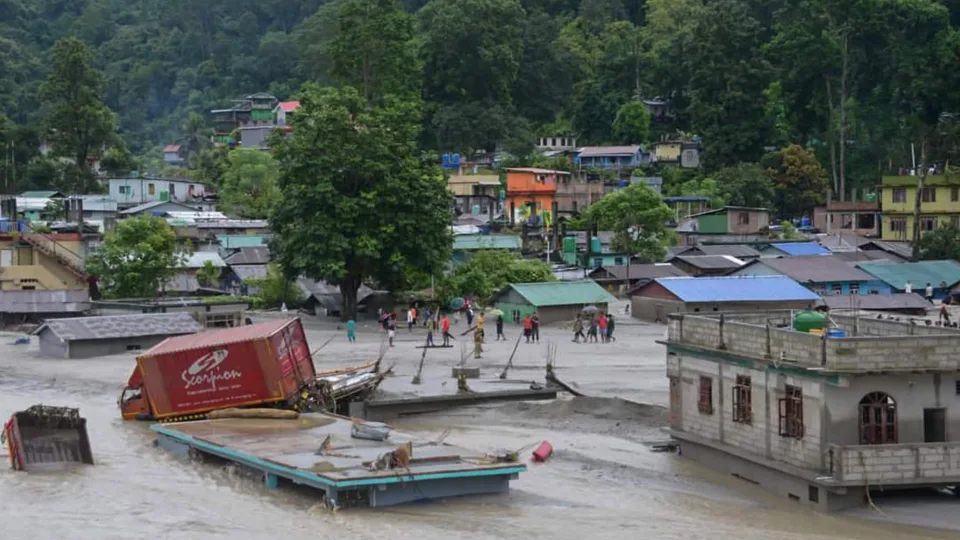
A vehicle that got washed away lies atop a submerged building after flash floods triggered by a sudden heavy rainfall swamped Rangpo town in Sikkim, India, on October 5.
Tragedy Strikes in India’s Northeast
After a glacial lake rupture in India’s northeast, prompted by intense rainfall, over 100 individuals remain missing. This occurrence resulted in catastrophic flash floods in the Himalayan state of Sikkim on the previous Wednesday, causing a minimum of 14 confirmed casualties. The state administration has documented significant infrastructure damage, encompassing roads and bridges.
Sudden Cloudburst Causes Havoc
Lhonak Lake, located in the state’s northern region, witnessed a sudden and severe rainstorm, commonly referred to as a “cloudburst.” The aftermath was catastrophic as the sudden deluge rushed down the Teesta River in Sikkim’s Lachen valley. The Indian Army noted that this caused the water levels to surge between 15-20 feet above the usual mark.
Key Infrastructure Destroyed
Chungthang Dam, also recognized as the Teesta 3 dam, which plays a vital role in the state’s major hydropower projects, was obliterated by the floods. The National Disaster Management Authority confirmed this in a recent statement. On top of that, essential utilities like drinking water and sewage treatment plants in the affected areas have suffered extensive damage, states the government.
Visual Insights into the Disaster
Videos and images emerging from the northern parts of the state depict a grim scenario. Footage reveals muddy waters swiftly breaching river banks, inundating homes and leaving them buried under mud and debris. There are also visuals of search operations, where teams are employing heavy machinery to excavate army vehicles submerged in the mud.
Rescue Operations in Progress
The government has mobilized resources for rescue and restoration efforts in the affected regions. Both state-level and national disaster management teams are actively participating in these operations.
Vulnerability of the Himalayan Region
The Himalayan region, often referred to as the world’s rooftop, is ecologically delicate. It has a history of susceptibility to landslides and flash floods. Although flooding in Sikkim isn’t uncommon, the frequency and intensity of such events are a growing concern.
Climate Crisis and Extreme Weather Events
Scientific consensus highlights an alarming trend: the escalating human-induced climate crisis is making extreme weather events both more common and more severe.

High water levels in the Teesta river in Sikkim, India, on October 4.

A vehicle that got washed away lies beneath a tree in Rangpo town in Sikkim, India.
Prakash
ISRO’s Dramatic Satellite Images
In the wake of the ongoing search operations, the Indian Space Research Organization (ISRO) unveiled striking satellite images that capture the magnitude of water released from Lhonak Lake after the cloudburst event.
Profile of Lhonak Lake
Lhonak Lake is a distinct bullet-shaped glacial lake, situated at the base of a melting glacier.
Understanding the Glacial Lake Outburst
A closer look at these images reveals a concerning statistic: over 60% of the lake’s water was emptied due to the intense rainstorm, resulting in a glacial lake outburst. This particular event occurs when excessive water levels in a glacial lake or compromised surrounding land or ice conditions cause the lake to rupture, unleashing torrents of water and debris down mountain slopes.
Comparative Analysis of the Lake’s Capacity
Comparing two satellite images provides a clear picture of the magnitude of this event. The first image, dated September 28, showcases the lake holding around 167.4 hectares of water. In contrast, an image from October 4 depicts a considerably reduced lake, containing roughly 60.3 hectares of water.
ISRO’s Statement on the Incident
Alongside the satellite images, ISRO provided commentary noting, “The lake has burst, leading to a drainage of about 105 hectares area… This likely resulted in a flash flood downstream, particularly affecting the Teesta River.”

Temporal changes in Lhonak Lake area as of September 17; September 28; and October 4.
Lhonak Lake’s High-Risk Profile
Lhonak Lake has long been on the radar of scientists, who’ve recognized it as one of the fastest-growing glacial lakes in the region. Numerous studies have flagged its high susceptibility to potential glacial outbursts.
State’s Proactive Measures on Lhonak Lake
Over the years, the state’s Disaster Management Authority has undertaken multiple expeditions to assess the lake. They concluded that a glacial outburst would likely lead to extensive destruction downstream, with significant loss of life and property. As an immediate solution, pipelines were set up at the lake to drain excess water. Furthermore, in May, a state consultation workshop was held discussing the risks, where the need for an early warning system for such lakes in Sikkim was emphasized.
Impact on Pakyong City
The city of Pakyong in Sikkim bore the brunt of the calamity. As per state reports, the floods claimed the lives of seven individuals and left 59 missing.
Challenges in Search Operations
A significant number of the missing include members of the Indian Army. Although a substantial search and rescue mission is underway, the continuous downpours and subsequent flooding have hindered the operation. The deluge has led to inaccessible roads and collapsed bridges. As of Wednesday evening, one soldier was found and is now stable, but 22 others are still unaccounted for.
Infrastructure Damage
The flood’s wrath was evident in its aftermath. At least 11 bridges gave way, further complicating rescue missions and isolating several regions. The government confirmed this massive infrastructure loss.
Casualties in Gangtok
Gangtok, the capital and the most populous city of Sikkim, reported three fatalities and 22 missing individuals due to the floods.
Relief Efforts Underway
In response to the disaster, over 2,000 residents were evacuated. The state has initiated relief camps to support more than 22,000 individuals affected by the sudden floods.

Rescue work continues after flash floods in Sikkim’s Rangpo town on October 5.
Prakash

Buildings are inundated by flood waters in Rangpo town.
Prakash
Rainfall Predictions for India
The India Meteorological Department anticipates persistent heavy rains in India’s eastern and northeastern regions, including Sikkim, over the next 48 hours.
Sikkim’s Chief Minister Takes Action
Prem Singh Tamang, Sikkim’s Chief Minister, took to X (previously known as Twitter) to relay that emergency services have been dispatched to flood-impacted regions. He also mentioned his visit to Singtam, a town around 30 kilometers from Gangtok, to gauge the damage and interact with the residents.
Indian PM Comments on the Disaster
Indian Prime Minister Narendra Modi labeled the event a “tragic natural disaster” and extended his promise of utmost support to address the repercussions. He conveyed his prayers and concern for the welfare of the affected populace on X.
The Himalayan Climate Crisis
The Himalayan region faces significant threats from the changing climate. These glaciers are pivotal, feeding rivers that cater to the freshwater needs of two billion people. Many societies rely on this glacial runoff for their agricultural practices.
The Future of Glacial Melting
A recent assessment presents a bleak outlook, forecasting a potential decline of as much as 80% in glacier ice by the close of the century due to escalating temperatures. This shift exacerbates vulnerabilities, including heightened threats of floods, landslides, avalanches, and even droughts. With global glaciers melting rapidly, approximately 15 million individuals living near glacial lakes are under threat from devastating outbursts. Shockingly, over half of this population resides in just four nations: India, Pakistan, Peru, and China, as per a study conducted earlier this year.

A vehicle is seen partially submerged in flood water in Rangpo town.
Prakash
The Sudden Peril of Glacial Outbursts
Floods resulting from glacial outbursts typically occur abruptly, giving residents minimal warning. Historical occurrences of such outbursts have resulted in the loss of thousands of lives and extensive property and infrastructure damage.
Recent Study on the Teesta River Basin
A 2020 investigation by the Indian Institute of Technology Guwahati on the Teesta River basin highlighted alarming changes. It identified a surge in rainfall and temperature levels in the 21st century. The study also pointed out that the numerous glacial lakes in Sikkim are expanding due to the melting of glaciers and snow as global temperatures climb.
Implications and Recommendations from Researchers
The team of scientists emphasized the hazards of heavy rainfall events, which could cause these lakes to suddenly expand, leading to the risk of glacial outburst floods. The researchers underscored the urgency for state disaster management units to be well-prepared for such crises. They also stressed the importance of policy makers adopting adaptive strategies to combat the challenges posed by climate change.
Past Tragedies in the Himalayan Region
Recalling a tragic event from 2021, a Himalayan glacier in Uttarakhand collapsed. This triggered a massive avalanche composed of water, dust, and boulders that barreled down a mountain gorge, devastating two hydroelectric projects and causing the death of at least 38 individuals.
Concerns from Northern Indian Communities
In northern India, local communities have long been raising alarms about unchecked commercial ventures, deforestation, and successive dam constructions in this ecologically delicate area. Such activities heighten the probabilities of disasters, including floods and landslides.


